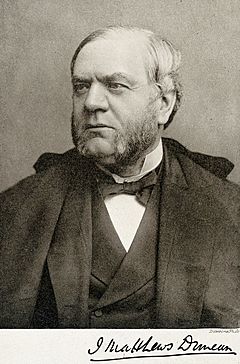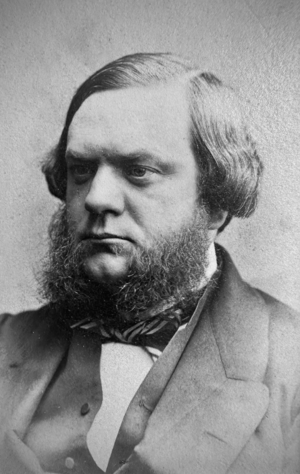James Matthews Duncan facts for kids
Quick facts for kids
James Matthews Duncan
|
|
|---|---|
 |
|
| Born | April 1826 |
| Died | 1 September 1890 (aged 64) |
| Nationality | Scottish |
| Education | Aberdeen grammar school |
| Alma mater | Marischal College, Aberdeen |
| Occupation | Physician, obstetrician |
Dr. James Matthews Duncan (born April 1826 – died 1 September 1890) was a Scottish doctor. He was very well-known for his work and writings about obstetrics. Obstetrics is the branch of medicine that deals with childbirth and the care of women during and after pregnancy. He was a Fellow of the Royal Society (FRS), which is a very important group for scientists.
Contents
Early Life and Education
James Matthews Duncan was born in Aberdeen, Scotland, on April 29, 1826. He was the fifth child of William Duncan, who was a merchant, and his wife Isabella Matthews.
He went to Aberdeen grammar school for his early education. After that, he studied medicine at Marischal College, Aberdeen, and earned his Master of Arts degree in April 1843. He continued his medical studies at Edinburgh University in 1845. By 1846, before he was even 21 years old, he had earned his Doctor of Medicine (M.D.) degree back in Aberdeen.
Medical Career and Discoveries
After finishing his studies in Scotland, Duncan spent the winter of 1846–1847 in Paris, France. There, he attended lectures by famous doctors like Gabriel Andral and Jean Cruveilhier.
When he returned to Edinburgh in April 1847, he became an assistant to Dr. James Young Simpson. Dr. Simpson was a pioneer in using anaesthetics (medicines that make you lose feeling or consciousness during surgery). Duncan helped Simpson with his experiments. On November 4, 1847, Duncan even inhaled chloroform himself to the point of losing consciousness. This was a brave step in understanding how anaesthetics worked.
Becoming an Obstetrician
In late 1849, after some travels, Duncan started his own medical practice in Edinburgh. He focused mainly on obstetrics, helping women with childbirth.
He became a fellow of the Royal College of Physicians of Edinburgh in 1851. In May 1853, he began teaching midwifery (the practice of assisting in childbirth) at the Edinburgh Extramural School of Medicine. His practice grew, and in 1861, he became a doctor for the women's diseases ward at the Royal Infirmary of Edinburgh.
Recognition and Move to London
In 1863, James Duncan was elected a Fellow of the Royal Society of Edinburgh. This showed how respected he was in the medical community. He also became a member of the Aesculapian Club in 1870. From 1873 to 1875, he was the president of the Edinburgh Obstetrical Society, which is a group for doctors specializing in childbirth.
In 1870, after Dr. Simpson passed away, Duncan hoped to become the professor of midwifery at Edinburgh University, but he was not chosen. However, in 1877, he was invited to teach midwifery at St. Bartholomew's Hospital in London and become an obstetrician there. This was a big opportunity, so he moved to London.
In London, he quickly became a member of the College of Physicians of London. In 1883, he was elected a fellow and gave important lectures called the Gulstonian lectures. On June 7, 1883, he was elected a Fellow of the Royal Society, which is one of the highest honors for scientists in the UK. In the same year, he was also appointed to the General Council of Medical Education and Registration.
Dr. Duncan's medical practice became very busy, and he was highly respected in his field. In 1890, his health began to decline. He went abroad in July and sadly passed away in Baden-Baden, Germany, on September 1, 1890, after several heart attacks.
Important Works
Dr. Duncan wrote many important papers and books about obstetrics. His book Fecundity, Fertility, and Sterility (1866) made him famous around the world as an expert in childbirth and related topics. A second edition of this book came out in 1871.
Some of his other important books include:
- Researches in Obstetrics (1868)
- The Mortality of Childbed and Maternity Hospitals (1870)
- Clinical Lectures on Diseases of Women (1879, with later editions)
Family Life
In 1860, James Duncan married Janet Hart Hotchkis. They had a large family with 13 children.
Medical Terms Named After Him
Because of his important contributions to medicine, some medical terms are named after Dr. James Matthews Duncan:
- Duncan curette: A special tool used in medical procedures.
- Duncan fold: Refers to certain folds on the surface of the uterus after childbirth.
- Duncan mechanism: One of the two ways the placenta (the organ that nourishes a baby during pregnancy) can be delivered after birth.
- Duncan ventricle: Another name for the cave of septum pellucidum, a space in the brain.


